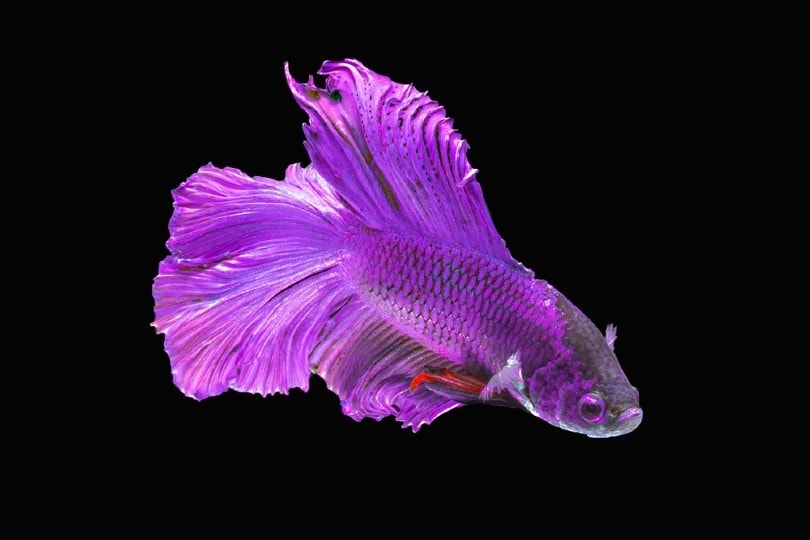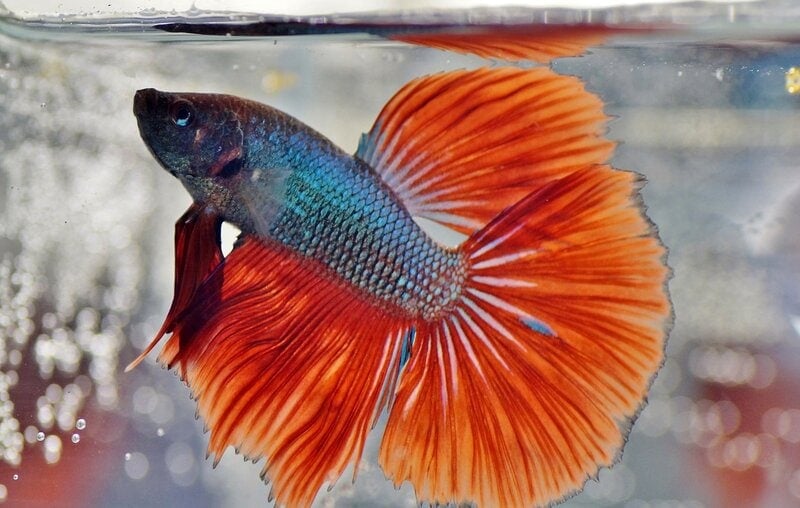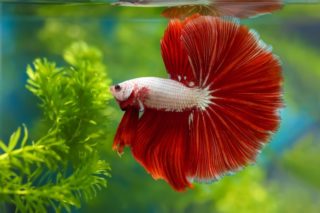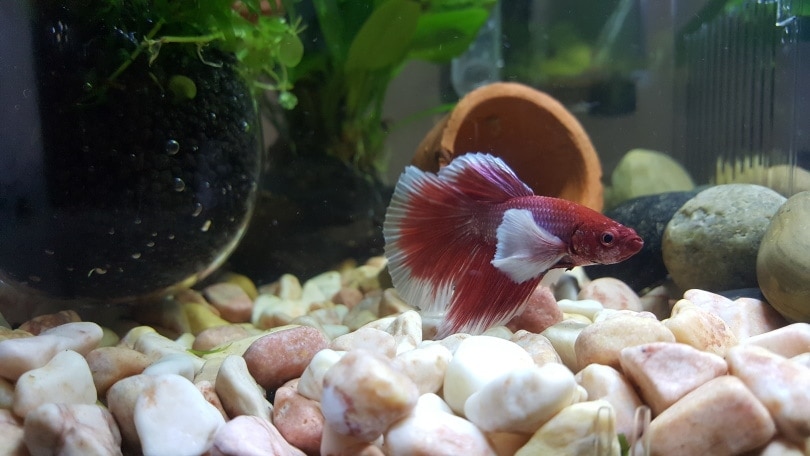Purple Betta Fish: Care Guide, Pictures, Varieties, & Lifespan

Updated on

Click to Skip Ahead
Betta fish can be more difficult to take care of than many people realize. They are often billed as “starter fish,” but this isn’t entirely true. Their aggressive nature makes it difficult to keep multiple fish together. You cannot keep male Betta fish together, as they will fight each other.
Their beautiful, elegant tails make them beautiful additions to any tank. These fish come in a variety of different colors, including purple.
Their popularity has led to a great deal of confusion about their care, though. For instance, they are often advertised as being able to live in bowls, but their true minimum tank size is closer to 10 gallons.
In this article, we cover everything that you need to know about these beautiful fish. If you take care of them, they can potentially live for years. Sadly, most die within the first year due to improper care. Keep reading to learn about keeping your purple Betta fish beautiful and vibrant.
Quick Facts About Purple Betta Fish
| Species Name: | Betta Splendens |
| Family: | Gourami |
| Care Level: | Moderate |
| Temperature: | 75–80 degrees Fahrenheit |
| Temperament: | Aggressive |
| Color Form: | Purple |
| Lifespan: | 10 years maximum |
| Size: | 2.25 to 2.5 inches |
| Diet: | Carnivores |
| Minimum Tank Size: | 10 gallons |
| Tank Set-Up: | Plenty of cover, low filtration, warm |
| Compatibility: | None |
Purple Betta Fish Overview
Betta fish are also called Siamese fighting fish due to their aggressive nature. They will usually attack other Betta fish, as they are extremely territorial. Females can sometimes be kept together, but only in large tanks with plenty of hiding spots.
These fish are native to Southeast Asia, particularly the central plain of Thailand. They have been domesticated longer than any fish and were initially used for fish fighting, which was a gambling sport similar to cockfighting. They first appeared in the West in the late 19th century and have become popular since then as ornamental fish.
They have a long history of selective breeding that has led to countless color varieties. They are like the “designer dog” of the fish world.
Their beautiful colorations and long fins make them extremely popular, especially for new fish keepers. However, they are not necessarily easy to care for. For instance, they cannot be fed fish flakes like other common species because they require a high-protein diet. This usually means that they need premium fish food that is primarily made out of other fish.
They are often advertised as being suitable for bowls, but this isn’t true. They do have a labyrinth organ, which means that they can intake oxygen at the surface of the water from the air, so they don’t need much oxygenated water. However, they produce just as much waste as other fish and need at least a 10-gallon tank to thrive. Bowls will simply become too dirty too quickly.
How Much Do Purple Betta Fish Cost?
The cost of a Betta Fish is usually attached to their color form and variety. Purple Betta fish can come in many different types, just like any other Betta. This will affect their overall pricing. Most purple Betta fish will cost around $10, though some may cost as much as $25. These aren’t expensive fish in any case.
It can be difficult to find a “true” purple Betta fish, though. Most will be some sort of purple-blue color. True purple Betta fish will be the most expensive, while blueish varieties may be cheaper.
Typical Behavior & Temperament
Betta fish are known for being aggressive. They are extremely territorial and will fight with members of their own species and similar-looking fish. However, this can vary a bit from fish to fish. Some will attack just about anything that moves, including your fingers. (Luckily, they are so small that their bites do not hurt.) Others are more docile and will get along with snails and certain bottom feeders.
In most cases, these fish cannot be kept in a community tank. They will either attack the other fish, or their fins will become nipped by others.
Betta fish are known as intelligent fish. Their exact behavioral patterns vary between individuals, and it is suggested that some of this is based on associative learning. In other words, they can adapt their behaviors based on certain stimuli. Many will learn that the appearance of their owner’s hand means that food is about to be dropped.
Both males and females will puff out their gill covers when intimidating other fish or attempting to court a member of the opposite sex. This can also occur if they are startled by a change in their environment. They tend to pale if frightened or in poor water conditions. They can also develop stripes that can give a clue to their current wellness.
Appearance and Varieties
Even within purple Betta fish, there are many different varieties. Betta fish have undergone thousands of years of selective breeding, which means that they come in many different forms.
Purple Betta fish can range from vivid violets to blue purples. Fish will change color according to their environment, so the color that you see at the store isn’t necessarily what you’ll end up with when you get the fish home. Most at the store are much paler than they will be when introduced to a more proper environment.
Many captive Bettas can also be multi-colored, so some may be purple only in certain areas. Some may even be iridescent and appear to change colors in different lighting. Some Bettas even look like Koi fish!
There are many finnage varieties as well. These can come in any color. Veiltail is the most common. These fish simply have long tails that hang downward. However, crowntail, halfmoon, plakat, double tail, and elephant ear can also regularly be found.
How to Take Care of Purple Betta Fish
Habitat, Tank Conditions & Set-up
Betta fish shouldn’t be put in fishbowls, despite what some companies advertise. Your fish needs at least a 10-gallon tank. More is often better. As tropical fish, they prefer warmer waters. You should keep it around 75–80 degrees Fahrenheit. A heater is necessary. Be sure to purchase one that matches the size of your fish tank.
These fish are highly sensitive to water changes, so you will need to adapt them to their new tank slowly. This involves floating them in their current container and slowly replacing the water. You can’t simply dump them into new water, or they may not survive.
You don’t necessarily need a filter for your Betta tank, but one is often recommended because it makes caring for the water easier. Sponge filters are preferable because they don’t have a strong flow. These fish cannot swim if the flow is too strong, so it must be kept in check.
Lighting is not necessary for these fish, though you can use artificial light to make it easier for you to see them if you wish.
These fish prefer plenty of cover. Their fins are extremely long and sensitive, though. If you use fake plants, it is recommended that you only use silk ones. Plastic varieties can tear your Betta’s fins. Real plants are recommended as well, as these are soft enough to not cause damage.
The substrate is not particularly important because these fish will spend most of their time at the top of the tank. Remember, they need access to fresh air at all times because they cannot get enough oxygen from water alone.
Are Purple Betta Fish Good Tank Mates?
No, these fish cannot be kept with other fish in most cases. They are territorial and aggressive. Most will attack anything that even looks like a Betta fish. The level of territorial behavior can vary from fish to fish, however. They tend to have their own personalities. Some will attack anything that moves, while others can get along with some other fish.
When choosing tankmates, make sure they do not have any sort of bright colors. Your Betta will see these fish as rivals, which is never a good thing. They should also reside in a different level of water than the Betta does. If another fish is hanging around the top, the Betta might attack them.
Nibbling fish should not be added either. The Betta has a long tail that is susceptible to bites. Even if the Betta doesn’t attack the other fish, their fins may become injured.
What to Feed Your Purple Betta Fish?
Betta fish are carnivores, so they need a high-protein diet. Most will do best with some sort of brine shrimp or blood worms. These can be found at most pet stores. It is important to keep your fish’s diet varied and rich in protein. They are not omnivores, like most other common fish.
Feed them floating pellets as their primary food source. Use pellets that have at least one protein source in the first five ingredients. Betta fish feed at the surface and may not chase food that sinks.
You need to be careful not to overfeed your Betta because they will eat until they get sick. Their stomach is about the size of their eyeball, so portion their food accordingly. Feed them about two to three pellets once a day. Don’t be tempted to feed them more, though most will act like they are starving all the time.
Keeping Your Betta Fish Healthy
Even when kept in clean and suitable tank conditions, Betta fish can get sick. This is one reason that we do not recommend them to new fish owners. They are hardy in low-oxygen water, but that doesn’t mean that they aren’t susceptible to diseases.
Fin rot is the most common disease that can harm these fish. Usually, this occurs when the fish’s fin is damaged, and the water isn’t clean enough for healing. The sore then becomes infected. The fin will continue to decay unless the infection is treated. Eventually, this can reach the body and cause body rot.
Ich is a parasite that can occur in some aquariums. This disease appears as white spots, which is the parasitic bug. The fish will become irritated and rub up against objects because they are itchy. Medication is often required to treat this parasite infection.
Cotton fin fungus can also occur. As the name suggests, this is a fungus that occurs on the fish’s fins and body. It looks like cotton. An anti-fungal is used to treat it.
Bacterial infections of all kinds can occur. These usually have the same symptoms: inflamed scales, cloudy eyes, and lethargy. These can become very serious very quickly.
Most diseases occur due to poor water conditions. However, some can occur even if your water conditions are nearly perfect. If your fish gets sick, it is likely a sign that your maintenance routine needs to change.
Breeding
Breeding Betta Fish is difficult. Therefore, it is not recommended for beginners. We suggest having a decent amount of experience with Bettas in particular before trying to breed them.
The main problem is that Bettas will often injure each other while mating. This can lead to diseases if the water conditions are not suitable. It can be difficult to tell when Betta fish are trying to breed or trying to fight, so it often isn’t possible to separate the fish before fighting occurs.
You will need a separate breeding tank because the water conditions need to be absolutely pristine. Do not use any substrate because the eggs will get stuck in it. You should keep the water flow very low and have a suitable heater. Get plenty of Christmas moss to provide hiding places for the fish, as well as Indian Almond leaves to make it easier for the male to build a bubble nest. A divider is also recommended.
Females prefer red and similar colors. This can be a bit of a problem for purple males because they are closer to blue than red in most cases. Breeding purple Bettas is therefore a bit more difficult.
At first, introduce the male and female on either side of the divider. They should be able to see each other easily. Keep an eye on their behavior. The male’s color should brighten if he is interested, while the female will darken in color. Eventually, the male will build a bubble nest. Do not attempt to breed until this is complete.
Once the nest is built, allow the fish to access each other. There will be a great deal of chasing and biting. At some point, the “mating dance” will begin. In some cases, the dance may be interrupted if one fish decides that it isn’t good enough. One may run and hide. This is why having plenty of moss in the tank is important. It provides an easy hiding spot for both fish.
After mating, the male will attach the eggs to his bubble nest. He will watch over them. In some cases, he may make a new nest and move the eggs there. Be aware that some males will eat unfertilized eggs.
After the fry hatch, the male will continue to watch them. The male will catch any falling fry or eggs that he sees and will search the bottom for babies that he missed. He will keep an eye on them until they are free-swimming. At this point, you need to remove the male for the fry’s safety.
Are Purple Betta Fish Suitable for Your Aquarium?
If you want a single, beautiful fish, a purple Betta may be the right answer for you. These fish need a decently large aquarium for their size. We recommend a 10-gallon tank at least. While Bettas are often advertised as beginner fish, this isn’t necessarily the case. They do require unique water parameters.
For instance, these fish need constant access to the air because they have a labyrinth organ. The decorations in the tank must be carefully chosen, as some can rip and tear the fish’s fins.
All that said, if you are dedicated to their care, Bettas can be beautiful and enjoyable fish.
Looking for more Betta varieties? Try:
Featured Image Credit: GracePhotos, Shutterstock










